Famous Buildings in Australia – Australian Architecture Styles
There are many famous buildings in Australia, and we are going to examine fifteen of these Australian buildings over the course of this article. We will discuss the characteristics, location, history, and uses of some of the most famous Australian landmarks. If you want to learn more about architecture in Australia and some of the most famous buildings in the country, then keep reading!
Contents
- 1 15 of the Most Famous Buildings in Australia
- 1.1 Vaucluse House (1803 – 1839) in Sydney
- 1.2 Melbourne Athenaeum (1839) in Melbourne
- 1.3 Flinders Street Railway Station (1854) in Melbourne
- 1.4 Royal Exhibition Building (1879 – 1880) in Melbourne
- 1.5 Queen Victoria Building (1893 – 1898) in Sydney
- 1.6 Cape Byron Light (1899 – 1901) in Byron Shire
- 1.7 Shrine of Remembrance (1934) in Melbourne
- 1.8 Sydney Opera House (1959 – 1973) in Sydney
- 1.9 Council House (1961 – 1963) in Perth
- 1.10 Sydney Tower (1970 – 1981) in Sydney
- 1.11 Parliament House (1981 – 1988) in Canberra
- 1.12 Rialto Towers (1982 – 1986) in Melbourne
- 1.13 Queensland Number One (2002 – 2005) in Queensland
- 1.14 Eureka Tower (2002 – 2006) in Melbourne
- 1.15 Infinity Tower (2009 – 2014) in Brisbane
- 2 Frequently Asked Questions
15 of the Most Famous Buildings in Australia
Below, we will examine fifteen of the most famous buildings in Australia. There are many famous buildings in the country other than these, but this list represents some of the most important and recognizable instances of Australian architecture. So, let’s get started and have a look at some of these famed structures.

Vaucluse House (1803 – 1839) in Sydney
| Architect | William Wentworth (1790 – 1872) |
| Date Constructed | 1803 – 1839 |
| Function | House museum |
| Location | Sydney, Australia |
Vaucluse House is a stunning example of architecture in Australia from some of the earliest periods of the country’s colonization. The house was once a residence and colonial-era farm, but it has since become a tourist attraction for all to see. The main building serves as a museum and the grounds serve as a public park, and the entire structure has become a famous building in Sydney.
The house was constructed in the 19th century and it’s one of the few such houses that sits near the Sydney Harbor that has not been altered from its original design.
This Australian building is constructed using a Gothic style that makes use of a variety of turrets, parapets, and verandah posts. The entire structure is surrounded by French windows alongside stunning shutters while the roof of this building is slated and made of galvanized iron. The structure, as a whole, is comprised of several different buildings, and there are two- and three-story buildings that are connected to one another that contains most of the rooms that would have once been used for entertainment purposes. Today, the once illustrious design of a building such as this is no longer reserved for a solitary family but instead serves as a public location for all to see.
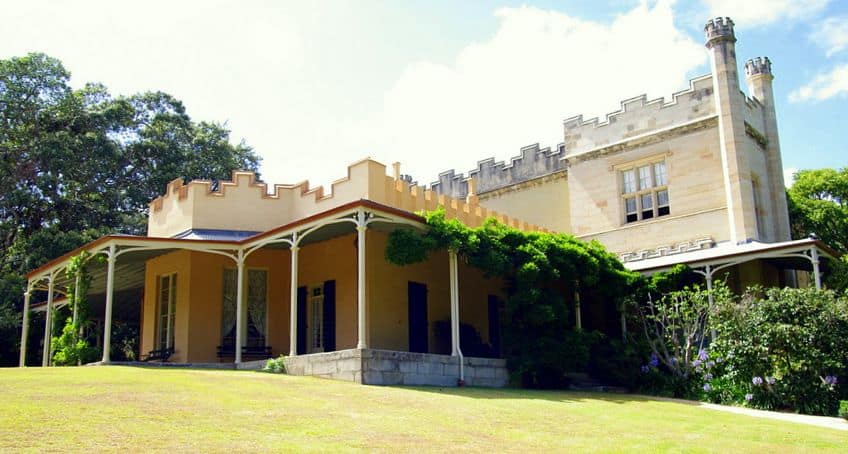
Melbourne Athenaeum (1839) in Melbourne
| Architect | Smith & Johnson |
| Date Constructed | 1839 |
| Function | Art and cultural hub |
| Location | Melbourne, Australia |
The Melbourne Athenaeum is an Australian building located within Melbourne, and it serves as an important art and cultural hub in the middle of the city. This building is one of the oldest such structures in the city, and it has become a famous Australian landmark in the area as it also sits within a central region surrounded by other art-oriented buildings.
The building is rather large and comprised of a number of different sub-sections, and these sub-sections include a large theater, a smaller theater, a library, and even a restaurant.
The building is, as a whole, an all-in-one cultural site that has served many other roles over the years, such as acting as a cinema and an art exhibit. These may no longer be the building’s functions, but it has retained its artistic and cultural importance in the realm of Australian architecture. Some of the main events that take place at this important Melbourne theater venue include various comedic and musical performances. The Melbourne Athenaeum is actually the primary location for the Melbourne International Comedy Festival as well as the Melbourne Opera. The location has served for many years as an important site in the city for the perpetuation of cultural activities.
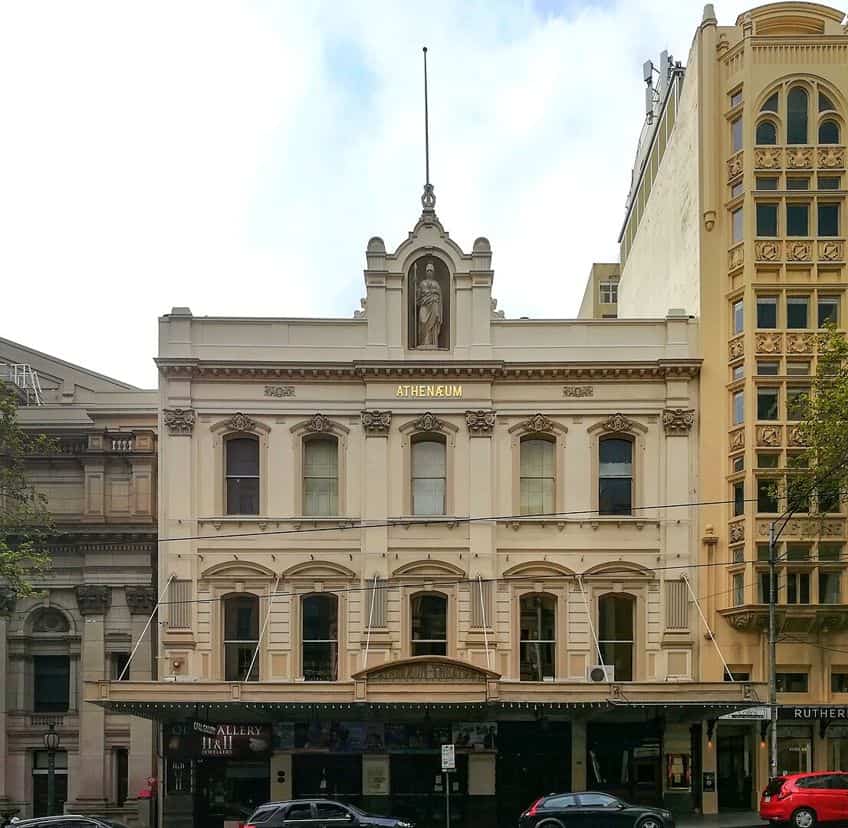
Flinders Street Railway Station (1854) in Melbourne
| Architect | Unknown |
| Date Constructed | 1854 |
| Function | Train station |
| Location | Melbourne, Australia |
Flinders Street Railway Station is an utterly gorgeous Australian building that can be found on the corner of Flinders and Swanston in Melbourne, hence the name. This famous Australian structure has served as a functioning railway station since it opened in 1854 and serves the entirety of the rail network in the eastern section of the state. This particular train station has served as the busiest station in Melbourne, and it was also, supposedly, the busiest passenger station in the world in the 1920s.
However, times have changed quite significantly since then and other railway stations have easily surpassed it, especially in some of the most populous locations on the planet.
One of the most notable features of this famous Australian railway station is the array of clocks under the main dome that indicate departure times for the trains in the station. These clocks have become some of the most famous of their kind in the world and have served this particular train station for many decades. These clocks even managed to survive digitization because as soon as a decision was reached to replace them, public outrage almost immediately reversed the decision.

Royal Exhibition Building (1879 – 1880) in Melbourne
| Architect | Joseph Reed (1823 – 1890) |
| Date Constructed | 1879 – 1880 |
| Function | Exhibition hall |
| Location | Melbourne |
The Royal Exhibition Building is an Australian building that also serves as one of the most famous Australian landmarks in the city of Melbourne. The building was constructed in the late 19th century as part of an international exhibition movement in which there were well over 50 exhibitions that were being opened all around the world between 1851 and 1915. The purpose of which was to aid in the development of artistic movements around the globe and to provide far more cultural works to the public. When the Royal Exhibition Building was opened to the public, it was done so to host the Melbourne International Exhibition of 1880 to 1881 (although it would later go on to host an even larger exhibition in 1888 called the Centennial International Exhibition).
However, the famous building was not without its difficulties, as this example of one of the most famous buildings in Australia was partially demolished. In fact, only the main building, which is known as the Great Hall, survived this fate.
The building has since seen extensive renovations, especially in the wake of it being awarded with the UNESCO World Heritage seal of international cultural approval, and it was the very first piece of Australian architecture to receive this privilege. The many renovations that were performed at the sight led to new staircases, floors, stonework, and the façade. However, the renovations have not come to an end as the Australian government has approved additional funds for new renovations. Buildings of such historical note need to be protected, and the maintenance of such structures requires constant and consistent work.
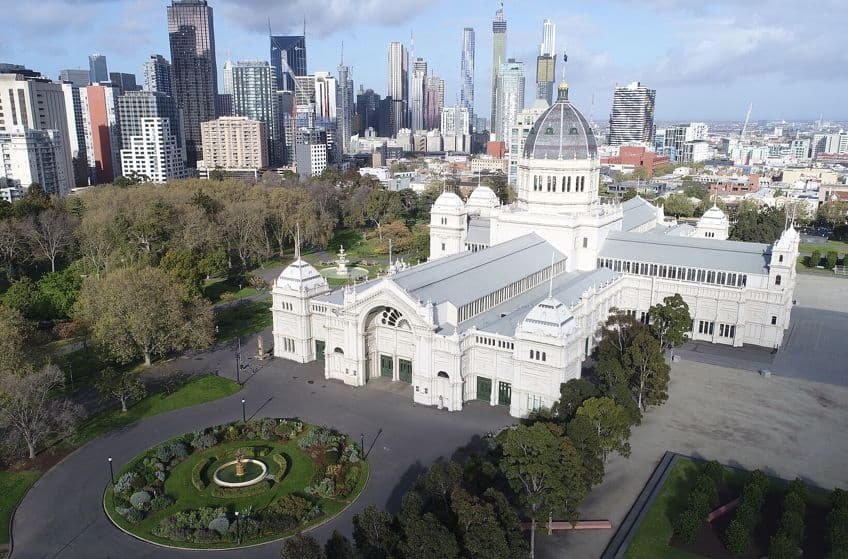
Queen Victoria Building (1893 – 1898) in Sydney
| Architect | George McRae (1857 – 1923) |
| Date Constructed | 1893 – 1898 |
| Function | Marketplace |
| Location | Sydney, Australia |
The Queen Victoria Building is a late-19th-century instance of Australian architecture and one of the most famous buildings in Australia in general. The building has since become a heritage site because of its immense importance, but the structure was constructed using a Romanesque Revival style (which tends to be underutilized in favor of some of the more illustrious ancient architectural styles), but the cathedral-inspired building now stands at 190 m (or 620 ft) long and 30 m (or 98 ft) wide, and so it is a massive structure in the city. The structure and its general cathedral scale and design were constructed at a time when Sydney was experiencing an economic boom, and it is designed around a vast array of arches, columns, colonnades, and balustrades.
However, the building is best known for its massive dome. The dome is comprised of an inner glass structure with a copper exterior, and there are a variety of smaller domes that adorn the rooftop.
Other cathedral-inspired aspects of this famous building in Sydney include the stained-glass windows that allow for light to filter through and into the structure while the rooftop is made up of various skylights that further add to the well-lit landmark. The building is, however, not a church in any way, shape, or form, and is instead a marketplace that is made up of numerous small shops that can be visited alongside the stunningly designed façade, interior, stained-glass adornments, and the two marble statue groups that stand above the entrance to the building. The Queen Victoria Building has gone on to become one of the most famous Australian landmarks and a stunning example of Australian architecture.

Cape Byron Light (1899 – 1901) in Byron Shire
| Architect | Charles Harding (1867 – 1944) and Cecil W. Darley (1842 – 1928) |
| Date Constructed | 1899 – 1901 |
| Function | Museum |
| Location | Byron Shire, Australia |
Cape Byron Light is an over-century old lighthouse located in Byron Shire, and it still works to this day, although it has attained a few new features over the years. The structure, which was once a lighthouse alone, has since become the location of several structures, such as an interpretive center, retail building, accommodation, and general tourist attraction. It may have once served a rather solitary function, but it now stands as an extensively used structure with a multitude of purposes that is owned and operated by a governmental agency.
The lighthouse itself is constructed around a circular design and it stands about 22 m (or 72 ft) in height. It is not the tallest building in the country, but it is one of the most famous Australian landmarks.
It is constructed atop a concrete foundation, uses a concrete staircase to the very top, a metal balustrade circles the interior, and an exterior concrete balcony contains its own trachyte balustrade. The lighthouse also contains a Chance Bros & Co lantern that operates to this day. The lighthouse structure contains a museum that can be visited alongside a lobby and service rooms, and this structure allows the head lighthouse keeper, as well as two assistants, to remain on-site to maintain the structure and its technical functions.

Shrine of Remembrance (1934) in Melbourne
| Architect | Hudson and Wardrop Associates |
| Date Constructed | 1934 |
| Function | Memorial |
| Location | Melbourne, Australia |
The Shrine of Remembrance is a World War I memorial structure located in Melbourne, and it has become one of the most famous buildings in Australia over the years. This particular memorial was constructed to honor all the citizens in Victoria who served in the First World War, but it has since become a war memorial for the entirety of Australia and not only one state within it. The memorial sees observances on both Anzac Day and Remembrance Day to commemorate those who served.
The memorial was, interestingly, designed by two World War I veterans, and they designed it with Classical inspiration and specifically took direct inspiration from both the Parthenon in Athens and the Mausoleum at Halicarnassus (which was also one of the Seven Wonders of the Ancient World before its destruction).
The most notable feature of this particular memorial is the ziggurat-style roof that tops the structure. The memorial contains the marble Stone of Remembrance, and that stone is positioned in such a way that a ray of sunlight beams down upon it just once a year. It lands on that stone at 11 am on 11 November every year, and that is because that was the official end date and time for the First World War. It is a remarkable sight and one that is used in a number of memorial locations, such as the Voortrekker Monument in South Africa.

Sydney Opera House (1959 – 1973) in Sydney
| Architect | Jørn Utzon (1918 – 2008) |
| Date Constructed | 1959 – 1973 |
| Function | Performing arts center |
| Location | Sydney, Australia |
When discussing the most famous buildings in Australia, one cannot ignore the building that is, by far, the most famous: the Sydney Opera House. This is a performing arts venue in Sydney and it is definitely the most famous building in Sydney. It has become representative of the city in the same way that the Statue of Liberty is to New York City. The city and the building can never be separated from one another ever again. It is also one of the most important buildings of the 20th century and an immensely distinctive structure in general. The Sydney Opera House was designed by the Danish architect Jørn Utzon, and he had many disagreements with those in charge throughout the course of the building’s design and construction.
It may have become one of the most famous instances of an expressionistic design, but the many distinctive “shell” designs have managed to transcend any kind of arguments that were had between those in charge of its construction.
The building, while not necessarily large in its overall size, has become one of the most recognizable architectural feats in the world. The “shell” designs, which are not technically shells in the architectural sense but have instead become commonly referred to by this term, are made of precast concrete and they each weigh about 15 tons apiece. These shells form the predominant roofing structure and have become immensely famous for their creamy white design. Other than architectural achievements, the Sydney Opera House has also served throughout its decades of service as a prime location for a variety of performance events in the city. The building may be half a century old already, but it shows no signs of losing any of the star power that it has managed to attain over its long and illustrious career as a performing arts center.
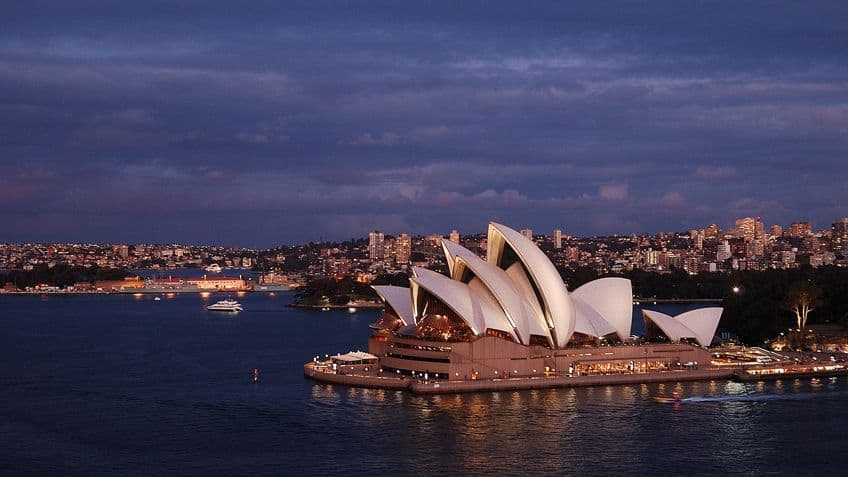
Council House (1961 – 1963) in Perth
| Architect | Howlett and Bailey Architects |
| Date Constructed | 1961 – 1963 |
| Function | Office building |
| Location | Perth, Australia |
The Council House in Perth is a 49.8 m (or 163 ft) tall office building that was originally opened by Queen Elizabeth II herself in 1963. The building, for most of its existence, has been used as the headquarters of the City of Perth, and as such it has formed an integral role in the operation of the city itself. The building on the other hand made use of a Modernist architectural style that was subject to intense debate as it was claimed that structures of that kind would not be historically viable.
However, in more recent years, it has become classified as a heritage site within the state despite the hesitation from many members of the public about the concrete-covered, steel frame structure.
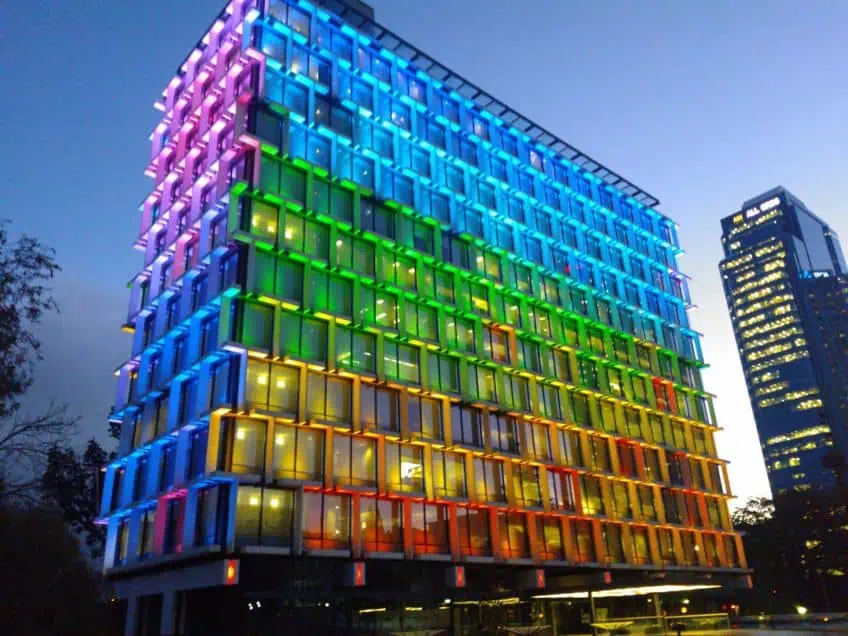
Sydney Tower (1970 – 1981) in Sydney
| Architect | Donald Crone & Associates |
| Date Constructed | 1970 – 1981 |
| Function | Observation tower |
| Location | Sydney, Australia |
Sydney Tower is a 309 (or 1,014 ft) tall skyscraper in Sydney and an important part of the city’s skyline. Because of its impressive height, it is the second-tallest observation tower in the Southern Hemisphere as well as being the tallest building in Sydney. While it may not be the most famous building in Sydney, seeing as the Sydney Opera House exists, it certainly is still one of the most famous in the city. The building has been used on a number of occasions for the launching of fireworks, and it has also often been illuminated in a variety of differently colored lights during certain celebrations in the city.
As the tallest point in Sydney, it is perfectly situated to serve as an integral aspect of the city’s most prominently used buildings.
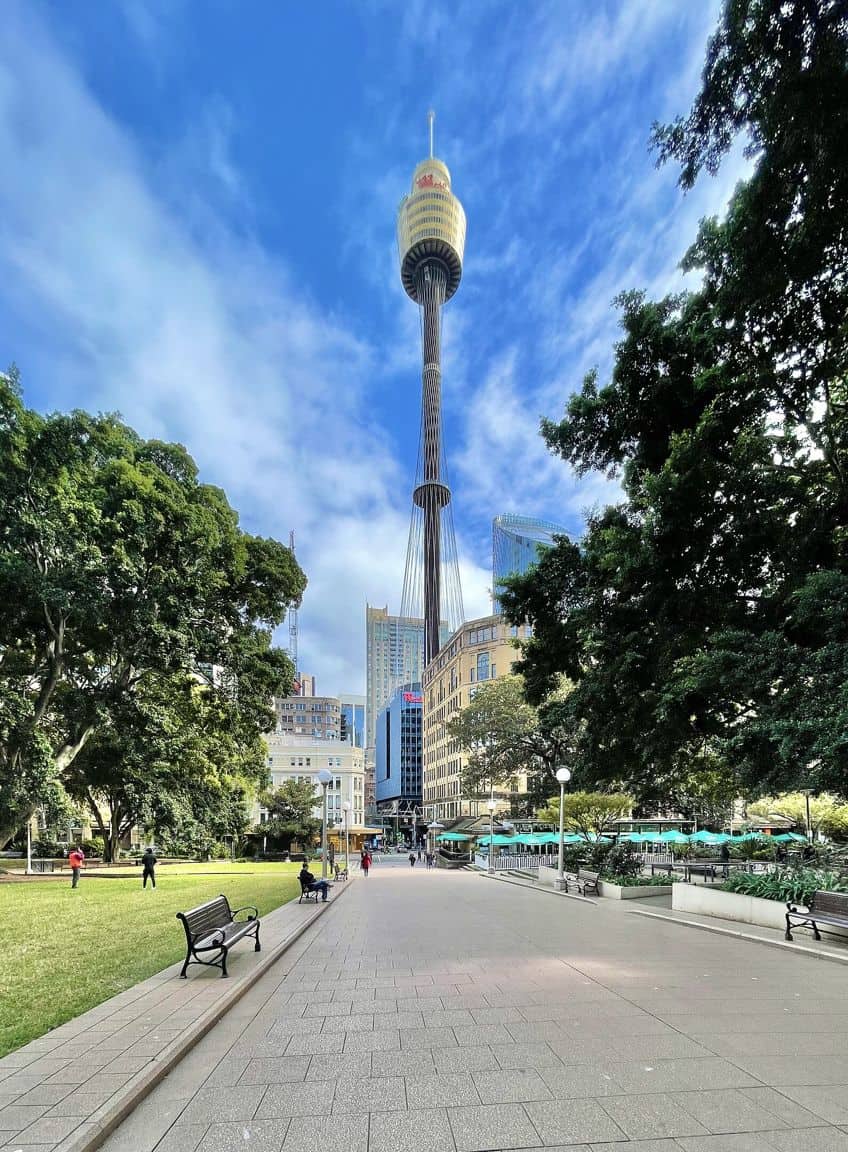
Parliament House (1981 – 1988) in Canberra
| Architect | Romaldo Giurgola (1920 – 2016) |
| Date Constructed | 1981 – 1988 |
| Function | Parliament building |
| Location | Canberra, Australia |
Parliament House is located in Canberra, the capital city of the country, and as the name of the building suggests, this is a parliament building. This means that it will always serve as one of the most recognizable and famous buildings in Australia by locals, but not necessarily by the rest of the world. However, the building is a rather interesting one that does not adopt the kinds of ordinary designs that are typically reserved for structures of this nature. The front of the building is a curious white construction that opens to a water feature and a large tapestry that is based on an Arthur Boyd painting (the original painting is also exhibited within the walls of the parliament building).
The interior of the building is not generally accessible to the public as various locations are, understandably, used for legislative purposes.
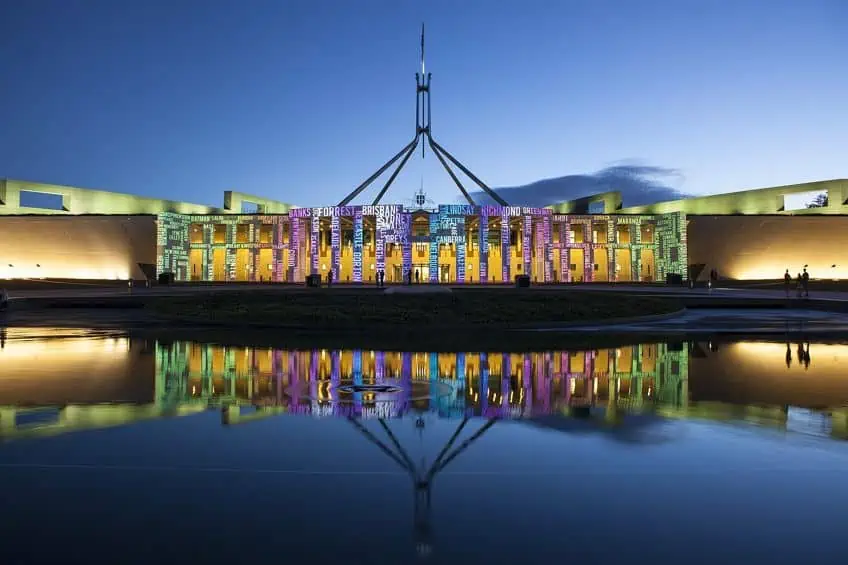
Rialto Towers (1982 – 1986) in Melbourne
| Architect | Gerard de Preu and Partners |
| Date Constructed | 1982 – 1986 |
| Function | Office building |
| Location | Melbourne, Australia |
Rialto Towers is a skyscraper that can be found in Melbourne, and this building was also the tallest office building in the Southern Hemisphere when it was built. It has since been replaced several times over, but at 251 m (or 823 ft) in height, it isn’t a small structure by any stretch of the imagination. The Rialto Towers also included the city’s first publicly available observation deck, although it is no longer available to the public.
It has since been replaced by a fine dining restaurant, and so it is still open to the public, but not as a simple observation deck, but rather as a restaurant that only a few will truly be able to attend.
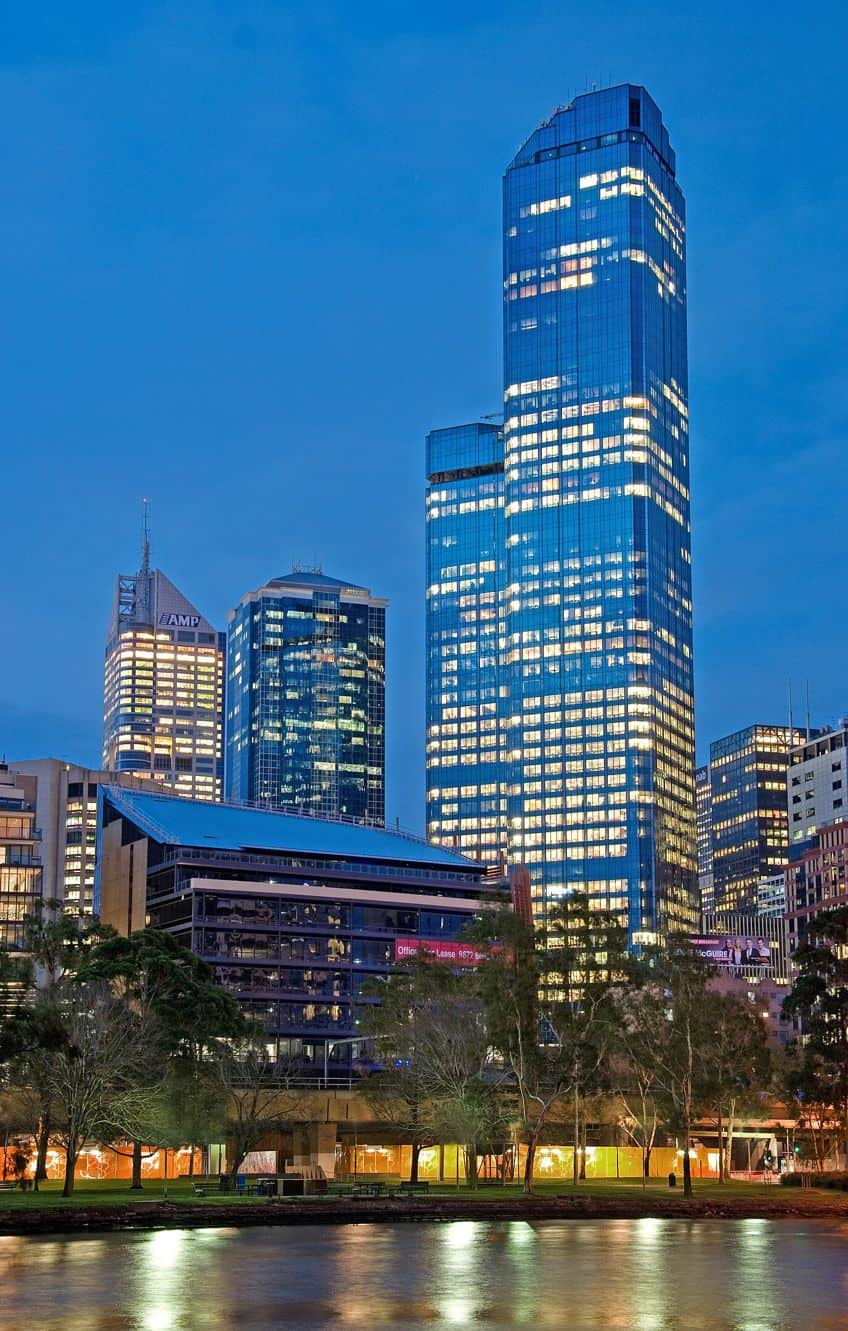
Queensland Number One (2002 – 2005) in Queensland
| Architect | Sunland Group |
| Date Constructed | 2002 – 2005 |
| Function | Residential |
| Location | Queensland, Australia |
Queensland Number One is a supertall skyscraper in Queensland, but it is more commonly known as the Q1 Tower. This tower is 322.5 m (or 1,058 ft) in height, and it is a residential tower that also served as the world’s tallest residential skyscraper until 2011. It is also, to this day, the second-tallest building in the Southern Hemisphere. In addition to this, it is the tallest building in Australia in general. It has become known as one of the most iconic and famous buildings in Australia, and an emblem of Queensland.
The skyscraper was designed by studying wind patterns and movements, and it makes use of a series of ribbon structures that wrap around the façade and cover the entry plaza.
This allows these ribbons to provide shade as they spiral their way to the very top of the building, and these aluminum ribbons serve to represent the movement of wind around the building. This stunning design allows the building to maintain an artistically rendered retail space and a general shopping district that has turned this into one of the most famous Australian landmarks. The Q1 Tower has maintained its place as one of the most stunning sights in the country ever since its construction was finalized in the mid-2000s.
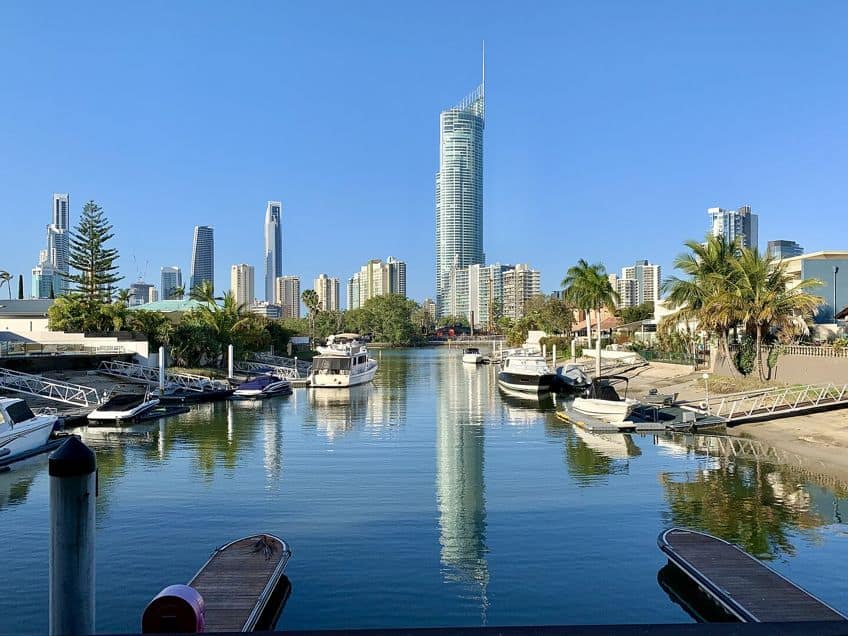
Eureka Tower (2002 – 2006) in Melbourne
| Architect | Fender Katsalidis |
| Date Constructed | 2002 – 2006 |
| Function | Mixed-use |
| Location | Melbourne, Australia |
Eureka Tower is a skyscraper in Melbourne that serves as one of the most prominent parts of the city’s skyline. The skyscraper stands at 297.3 m (or 975 ft) tall, and it serves as a mixed-use structure that once served as the tallest skyscraper in the city. It served this role from its topping out in 2006 until 2020 when the newly constructed Australia 108 was completed. However, it is still the third tallest building in the country, and so it does still serve as one of the most famous buildings in Australia.
The building itself was named after the Eureka Stockade, which was a rebellion that occurred during a gold rush in 1854 in the state, and so the structure makes reference to that historical event through the use of a golden crown atop the building and a red stripe that runs down the structure to represent the blood that was spilled (which is a rather morbid architectural feature to include on a building’s façade, but it certainly does give the skyscraper a unique aesthetic in Australian architecture.
The observation deck of the Eureka Tower is the highest such point in the Southern Hemisphere at 285 m (or 935 ft), and it is open to the public. Whereas on the opposite side of the tower, at the very bottom, there is a fascinating art installation that contains bee sculptures. The art installation is made to resemble a beehive and there is one queen bee atop the installation flanked by two regular bees. The bees are also rendered in gold to further emphasize the influence of the Eureka Stockade on the building’s construction.
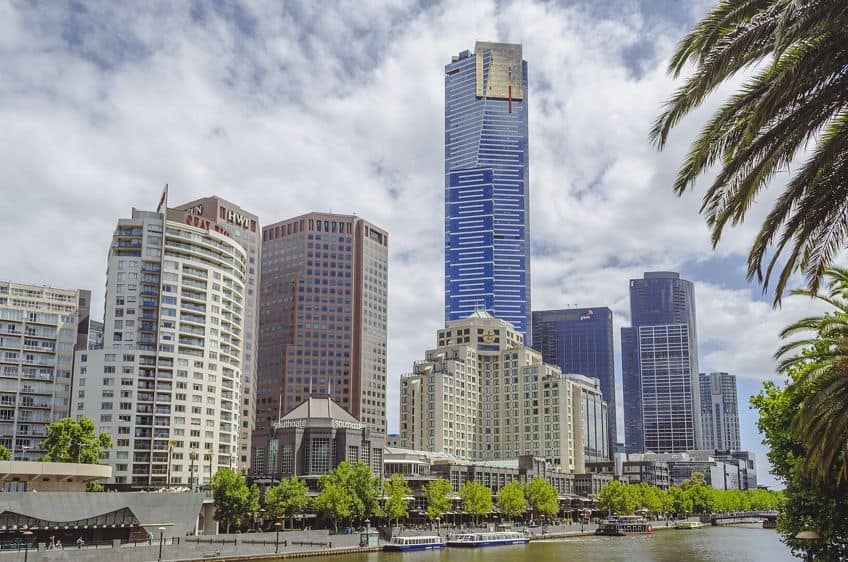
Infinity Tower (2009 – 2014) in Brisbane
| Architect | DBI Architecture |
| Date Constructed | 2009 – 2014 |
| Function | Residential |
| Location | Brisbane, Australia |
The Infinity Tower in Brisbane, which is not to be confused with the Cayan Tower in Dubai (which is also known as the Infinity Tower, so when one is looking at some of these examples of architecture in Australia, it becomes necessary to specify the location as well as the name of the building. The Infinity Tower, in Brisbane, is a 249 m (or 817 ft) skyscraper that served as the tallest building in Brisbane for about two years before it was surpassed by 1 William Street.

The Australian building has become a famous Australian landmark in Brisbane, and it consists of a series of both serviced and residential apartments. The overall land on which the structure was built is relatively small, but because of the scale, it is able to house 549 units in total, and so it has managed to provide housing to a significant portion of the city’s population in the region. However, the Infinity Tower is more in the realm of luxury locales, as it includes a spa, sauna, private gym, and pool, and so it serves as a location to house some of the city’s wealthier population. However, the structure has served as a stunning piece of Australian architecture with its cylindrical shape and its contribution to the Brisbane skyline.
We have come to the end of our look at famous buildings in Australia. We have examined fifteen different pieces of Australian architecture and some of its history, uses, and characteristics. Australia includes some of the world’s most stunning buildings, and hopefully, you’ve learned a good deal about some of those buildings along the way. All that’s left for us to do now is to wish you a great day/week/month ahead!
Frequently Asked Questions
Who Is the Most Famous Australian Architect?
It’s possible that Harry Seidler is the most famous Australian architect. However, this famous architect, who served as one of the leading members of Modernism in Australia and the world, was actually born in Austria. Regardless, he became known as an Australian architect and went on to design some of the most famous buildings in Australia. He often did so by using ideas and techniques taken from the Bauhaus school of design and architecture.
What Is the Most Famous Building in Australia?
The most famous building in Australia is, undeniably, the Sydney Opera House. Even those who know nothing at all about architecture are familiar with this building. Whenever any piece of media is filmed in or around Sydney, there will be a shot of this famous opera house. This building is to Sydney and Australia what Christ the Redeemer is to Rio de Janeiro and Brazil, and what the Eiffel Tower is to Paris and France. It was also one of the contenders for the New Seven Wonders of the World, but it ultimately lost that honor.
Are There Any Uniquely Australian Architectural Styles?
Several Australian architectural styles have developed over the centuries, but many of them have been adaptations of other styles. For instance, many of the styles that developed in Australia during the Victorian Era, with styles like Victorian Free Classical and Victorian Italianate, became prominent Australian iterations of these styles.
Justin van Huyssteen is a writer, academic, and educator from Cape Town, South Africa. He holds a master’s degree in Theory of Literature. His primary focus in this field is the analysis of artistic objects through a number of theoretical lenses. His predominant theoretical areas of interest include narratology and critical theory in general, with a particular focus on animal studies. Other than academia, he is a novelist, game reviewer, and freelance writer. Justin’s preferred architectural movements include the more modern and postmodern types of architecture, such as Bauhaus, Art Nouveau, Art Deco, Brutalist, and Futurist varieties like sustainable architecture. Justin is working for artfilemagazine as an author and content writer since 2022. He is responsible for all blog posts about architecture.
Learn more about Justin van Huyssteen and about us.
Cite this Article
Justin, van Huyssteen, “Famous Buildings in Australia – Australian Architecture Styles.” artfilemagazine – Your Online Art Source. July 5, 2023. URL: https://artfilemagazine.com/famous-buildings-in-australia/
van Huyssteen, J. (2023, 5 July). Famous Buildings in Australia – Australian Architecture Styles. artfilemagazine – Your Online Art Source. https://artfilemagazine.com/famous-buildings-in-australia/
van Huyssteen, Justin. “Famous Buildings in Australia – Australian Architecture Styles.” artfilemagazine – Your Online Art Source, July 5, 2023. https://artfilemagazine.com/famous-buildings-in-australia/.


